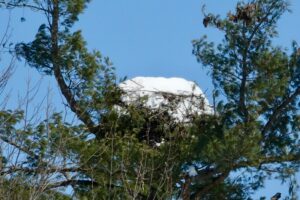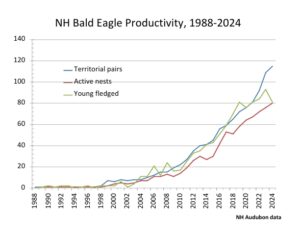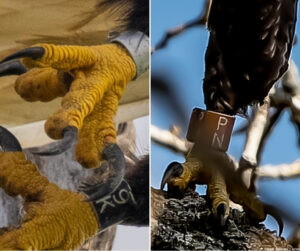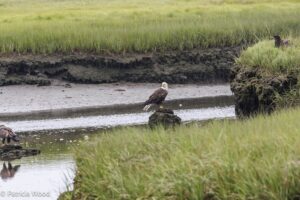(by Chris Martin)

The 2024 New Hampshire Bald Eagle nesting season was hit by two major snow events (March 23 and April 5) that took place when eagle pairs were incubating eggs or tending small chicks. While NH Audubon conservation staff and field volunteers found more territorial pairs and active nests than ever before, the number of successful nests and fledglings were both down. We confirmed 115 TERRITORIAL PAIRS and 80 PAIRS INCUBATING, both new record highs up by 5% compared to 2023. But we tallied only 55 SUCCESSFUL NESTS, down 10% from 2023. And the 81 YOUNG FLEDGED was off 13% from the record-high 93 fledglings in 2023. Eagles generally incubate faithfully, even in storms, but there are limits! Snow that accumulates to >18 inches can pack in around eggs during incubation and chill/kill embryos.

New Hampshire Fish & Game (NHFG) removed the Bald Eagle from the NH Endangered and Threatened Wildlife List in March 2017 after NH Audubon and our state and federal wildlife partners documented 20 years of strong population growth. Looking back this was clearly the right decision, and the population has continued to expand since then. In April 2024, NHFG produced a heart-warming 3-minute YouTube video about one rehabbed eagle released in New Ipswich. We continue to collaborate with NHFG Conservation Officers, Maria Colby and Wings of the Dawn Wildlife Rehabilitation Center in Henniker, and other rehabbers and wildlife veterinarians to return eagles to the wild whenever possible. But hazards remain, including vehicle strikes, use of lead tackle and shot, and potent second-generation anticoagulant rodenticides that impact a wide variety of non-target animals.

On the topic of environmental hazards, we once again collaborated with valued colleagues from Maine’s Biodiversity Research Institute (BRI) in May 2024 to collect blood and feather samples from 10 eaglets at 5 NH nests. That makes 18 eaglets from 9 NH nests in the past two years. These tissue samples will be analyzed for PFAS and other environmental toxins, and we hope to share results with you when they become available. While handling these young birds, we also place coded ID bands on them so that we might relocate them in future years.
In 2024, volunteers helped us identify 11 new breeding territories statewide compared to what we knew of in 2023. These included two new productive nests in Wakefield and another one in Rye. Even a new pair of sub-adult eagles that settled in on Highland Lake in Andover fledged one chick in mid-August. Wildlife photographers helped us reconfirm IDs on several breeding adults, including 2 birds living in adjacent Connecticut River territories in Hinsdale; a 17-yr old female ‘Black 9/K’ originally raised at Barkhampsted Reservoir in Connecticut and an 8-yr old male ‘Orange P/N’ fledged from Quabbin Reservoir in Massachusetts.


Back in 2019, under terms of our State Wildlife Grant (SWG) contract with NHFG, we partitioned NH into 5 similar-sized eagle monitoring zones. In 2024, the ‘Coastal’ zone was again our top focus for surveys, as it also had been in 2019. In 2024, we found 20 territorial pairs in the Coastal zone that produced 17 fledglings, and this included 8 territorial pairs that were not present when we last focused on this area in 2019. Our annual SWG contract with NHFG covers just part of the monitoring and management work that NH Audubon does with Bald Eagles. We depend on additional financial support from foundations and individual donors to continue to track these incredible birds statewide. Please consider making a gift to sustain our work for the coming year. And “thank you!” to all of you who volunteer your time and talents in the field to help us monitor eagles, NH Audubon would not be able to continue our statewide monitoring without your help!
